BUILDING BASICS
Sharing a Vision
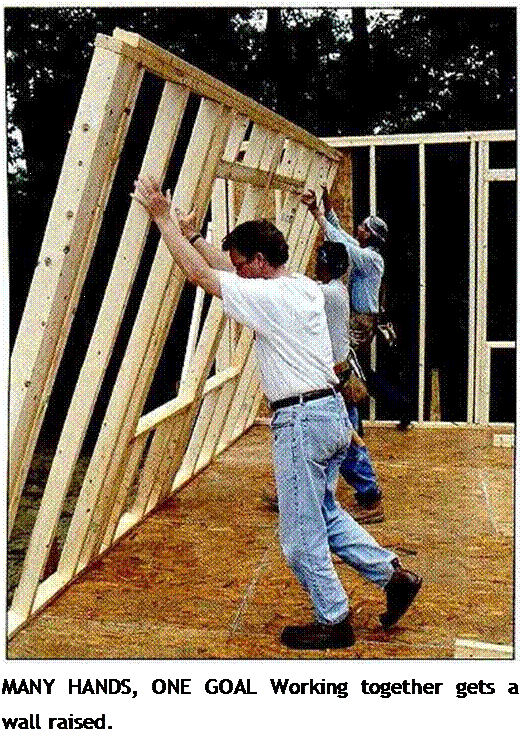
IT IS IMPORTANT TO HAVE a decent place to live. Most of us don’t want to live in a mansion. We only want a clean, safe place where we can live and raise our children. A decent house uplifts our spirits and provides dignity and hope for the future.
It is hard for many people to realize what it’s like to live in a moldy, leaky house with rat holes in the wall and plumbing that’s inadequate or nonexistent. Yet that is the condition of millions of people living around the world today. Poor housing is not just somewhere else, livery city in this country has its share.
Habitat for Humanity has a goal of eliminating poor housing by working
with families who need a hand up. There is no magic wand to wave that will produce a new home. Decent housing is built because people like you and me roll up our sleeves, pick up our hammers, and start building. What we may not be able to do alone can be accomplished when we work together. Lots of sweat, a little skill, and a shared vision get the job done.
During this process of working together, we build much more than houses. We meet all kinds of interesting people and develop close friendships as we work side by side, take breaks together, and share stories.



ensure that less-experienced workers are able to contribute meaningfully and feel good about the work they are doing.
Display patience, understanding, and openness
People of all ages and abilities come to Habitat job sites wanting to work. Try to give them work that they can do successfully, so that more than just a house is built. Sometimes it’s easy to get along with your coworkers; at other times, it’s quite challenging. You’ll find this to be true on a Habitat project, on your own construction site, and in every situation in life. We all know what it’s like to work with people who are arrogant, have an attitude, or are
unwilling to listen and learn. We also know what’s it’s like to work with people who treat us as equals, listen to us, show patience when we are trying to learn a new skill, and praise our efforts even when we fall short of expectations. fry to be the latter, and have patience with the former.
The checklist on the following pages contains most of the major steps involved in building a small house. Naturally, there will always be unforeseen or site-specific steps, but this list should serve as a fairly thorough guide to building a house, from raw idea to move-in day.
a Look for land and determine whether you
4
can build on it.
a Acquire a piece of land.
a Survey vour land to confirm the boundaries.
a Buy or draw up plans or acquire plans through Habitat (see Resources on p. 278),
a Obtain permits from the building depart ment and other departments, if necessary.
a Contact subcontractors for the foundation, plumbing, electrical, heating, lumber, and material companies. Get bids on work and materials. Select subcontractors and suppliers. Schedule work and deliveries.
a Take out liability insurance.
a Contact the gas, electric, and telephone companies to locate on-site utilities.
a Prepare the site.
a Bring in temporary electrical power.
a Trench and prepare for concrete footings and a foundation or slab.
a Before pouring concrete, lay down a gravel bed and install a plastic moisture barrier, if necessary.
a Call the building department to schedule an inspection of the concrete foundation footing and reinforcing steel.
a Have the footings and then the foundation or slab poured.
a Have the floor framing and sheathing materials delivered.
a Frame the subfloor.
a Install the rough plumbing (water, gas, and waste lines) and heating pipes.
a Call the building department for the floor
joist framing, rough plumbing, and heating inspections.
-a Sheathe the floor.
a Have the wall framing and wall sheathing materials delivered.
a Place chalklines on the floor to show the wall locations.
a Plate the walls, then cut and locate the headers. Frame and erect the walls.
a Brace the walls straight and plumb.
a Place the shower-tub units in the bathrooms; cover them to protect the fiberglass.
a Sheathe the walls, if necessary.
a – Have materials delivered for the exterior porch, deck, and stairs. Build the porch, deck, and stairs. After they’re built, cover the decks and stairs with scraps of OSB to protect them until the job is finished.
a Order the roof trusses at least two weeks in advance of your anticipated need.
ж Have the roof sheathing, fascia, and trusses delivered.
^ Install the trusses.
^ Install the fascia or gutter board and the barge rafters.
^ Install the roof sheathing on the trusses and the felt underlay on the sheathing.
a If required, have the roof sheathing inspected.
^ Call the plumber to put vent and exhaust pipes through the roof.
^ Shingle the roof. Install the ridge vent.
Doors, windows, siding, and paint
ж Order the windows and exterior doors two to three weeks before your anticipated need.
a Plumb the trimmers and install the windows and doors.
a Install the housewrap and exterior vapor barrier where needed.
 |
 |
|
 ^ Have the siding and trim delivered; cover them with plastic for protection. Prime both sides of the wood siding and trim (if using). Install ihe siding.
^ Have the siding and trim delivered; cover them with plastic for protection. Prime both sides of the wood siding and trim (if using). Install ihe siding.
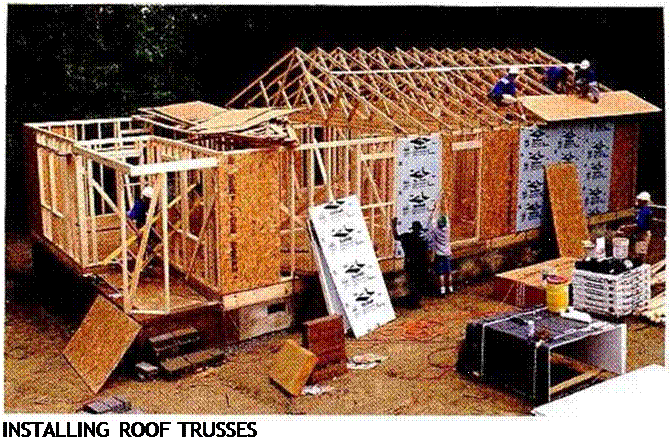

 |
 a Paint the exterior.
a Paint the exterior.
a Install the cutters.
a Install the rough electrical, heating and/or cooling ductwork, and gas lines.
a Install the cables for the telephone, television, and doorbell.
a Schedule and have inspections for the rough framing and the electrical, plumbing, and heating systems.
a Insulate the walls, ceilings, and floors.
a Install the interior vapor barrier where needed.
a Schedule the insulation and vapor barrier inspections.
|
FINISHING VINYL-SIDING WORK |
a Have the drywall delivered. Install drywall on the walls and ceilings.
^ Schedule and have the drywall nailing (or screw) inspection.
a Tape and finish the drywall.
^ Paint the interior trim and walls.
^ Install the underlayment for the vinyl floor covering.
a Put down the vinyl floors.
ж Install all remaining finish floors (wood, tile, etc.) except for carpeting.
Protect the floors until the construction is completed and all major appliances are installed.
|
INSTALLING FIBERGLASS ВАТТ INSULATION |
^ Install the cabinets and countertops.
a Order prehung interior doors two weeks before your anticipated need. Install the doors.
^ Have the trim—door and window casings, baseboards, windowsills, aprons, and closet shelves and poles—delivered. Install the trim.
^ Prime, paint, and finish-coat the doors and trim. Touch up where necessary.
|
NAILING UP DRYWALL |
a Install the finish plumbing and the electrical and heating units.
a Install the door locks.
a Install the medicine cabinet, towel bars, closet poles, and other hardware and fixtures.
a Lay wall-to-wall carpeting.
a Complete the work on the driveway and walkways (where applicable).
a Put on the house number. Set up the mailbox.
a Grade around the house sc the ground slopes and drains water away from the house.
a Landscape. Plant trees, grass, shrubs, and flowers.

 a Schedule the final inspection.
a Schedule the final inspection.
|
INSTALLING AN INTERIOR PREHUNG DOOR |
If you can draw it, you can build itIf you’re drawing your own plans, the process— though slow and often frustrating—will give you a clearer understanding of your house than many builders ever have. It can save vou from making costly mistakes and will likely contribute to building a better house. A good wav to test vour ability to visualize a house design based on plans is to visit some building sites where vou can examine both the plans and the actual construction details as the house goes up. If you’ve bought stock plans, they may seem bewildering initially; as you work with them, they’ll become much easier to read and understand. The ability to both draw and read plans gets easier with experience.
FRONT ELEVATION EAST Building a house is a process that consists of a seemingly endless number of steps. Knowing which step follows which—for example» when to call the electrical company 😮 install a temporary power pole, when to call the plumber to install drains and vents in the joist system— is key to organizing tasks and materials so that work isn’t held up. This knowledge comes primarily from experience, but for the firsttime builder I’ve listed most of the steps in the process (see pp. 16-21).
Techniques READING FLOOR PLANS
ж Elevation plan to show how each side of the house will look. Elevation drawings show the foundation, wall height, siding and trim, roof style and pitch, and roof overhang at the eaves. ж Detail plans to provide close-up views of small sections of the house. These are useful lor providing clarification or additional detail that isn’t shown in the other drawings. STEP 4 Secure the Building PermitsIt’s not uncommon for builders or owner – builders to view the local building department as enemy turf. Let me suggest that your building experience will be immeasurably more positive, productive, and efficient if you view the building department as a resource and think of the building inspector as someone who can help you. Certainly there are excep
tions, as there are in any field, but, by and large, building departments and building inspectors exist to protect prospective home – owners from unscrupulous or incompetent builders and owner-builders from themselves. The building inspector knows the building codes, which have been developed over the years to ensure that safe, durable houses are built. Your building inspector has the same goals that vou do. He or she wants a house Г1 j that doesn’t leak, isn’t a fire hazard, and can stand up to everyday use and all but the most severe natural disasters. Building inspectors really are on your side. Taking the plans to a building department to request permits need not be a big affair. I have often submitted basic plans on 1 I-in. by 14- in. sheets of paper. Plans do need to be drawn to scale, and the most common scale is 14 in. – 1 ft.; this means that 1 in. on a plan equals 4 ft. in the actual house. Using graph paper can help with preliminary
designing, but an inexpensive computer-aided design (CAD) program makes professionallooking plans that are simple to draw and easy to change. For a simple house, most building departments need the basic types of drawings shown on pp. 12, 14, and 15: a Plot or site plan to give an overall view from above, showing the shape and dimensions of the property and the size and location of the building. a Foundation plan to show the location and size of the concrete footings, walls, and piers that will support the floor frame. a Floor plan to provide a bird’s-eye view of the size and arrangement of living spaces. The floor plan shows the location and size of doors and windows and often the location of electrical, plumbing, and heating system components (see the symbols explained below). Even the location, spacing, and direction of the roof trusses can be found here. Design for the futureConsider building a wheelchair ramp leading to an entry or at least providing гост fora ramp to be built in the future. An accessible ramp has a 1 – in-12 rise (1 ft. of rise for every 12 ft. of length). When designing a house, its smart it) look beyond what your needs are today. Try to think about and allow for expansion in the future. An addition to the family—whether a new child or an elderly parent—often requires adding a bedroom. If you plan ahead, you 11 have room to expand when vou need to. This can save a lot of work and monev down the line. Whether we admit it or not, we all respond emotionally to our surroundings. Buildings create interior environments that can be drab, distinctive, inspiring, or discouraging. How a building looks, how its laid out, the materials used—all these influence how we feel. Ive visited huge, expensive homes that were not very inviting. Just because a house is big does not mean that it is warm and attractive.
Even a small, plain house can be made to feel inviting and uplifting, giving us pleasure, raising our spirits, and making us feel safe and secure (see the photo on the facing page). In the years that IVc been a Habitat volunteer, Eve had the opportunity to give a few humble houses a bit more personality and life than they’d otherwise have had. In this book, J’ve 4 tried to include many of the lessons I’ve learned—things such as ensuring that there are two sources of light in every room. Simple things like this can help make rooms bright and cheerv. / Ask the right questions Getting the details right will make life more convenient when vou move into vour house. / / Details also present many opportunities to make spaces special by using color schemes, hardware, unique materials, and built-in features (see the photo at right). As you’re working out your house’s design, ask yourself these key questions: “Is there a place to set groceries when I enter? Where will we hang up our coats or take off our boots when we come inside in the winter? Is il easy to get food to the table and to clear the dishes?” More than anything else you do, thinking about how you will actually live in the house will help you refine its design and ensure that the experience of living in it is a pleasant one. Provide a fence for safety and securityInstalling a fence around your site is a good idea. It can deter or prevent the theft of tools and building materials. It also makes the site safer by discouraging unauthorized visits.
Liability insurance is also a good idea, and it may even be required if you’re borrowing money from a bank. Always work to keep your site safe, organized, and free of debris, especially boards with nails protruding from them. Stack unused materials neatly, keep trenches covered, and limit access to anv unsafe areas. One nail in a worker’s foot or a bad ankle sprain from tripping into a trench can cost a lot of time in medical attention and recovery. The bumper-sticker slogan, “Live Simply That Others May Simply Live,” speaks to the design aspects of an affordable house. To increase the cost of a house, all you need to do is complicate its design. Affordable housing is, by nature, small and simple. The same formula that makes for a safe house in earthquake country—small, low, and light—makes for an affordable house anywhere in the country. The Charlotte house featured throughout this hook is one of the most cost-efficient designs you can build (see the photo at right). This single-story structure has a simple gable roof that extends over a small porch, where the main entry is located. On a small lot, where setbacks seriously limit the footprint of the house, you may need to consider a small, two-story design. Habitat for Humanity has a good selection of basic house plans that fit the needs of most families (see Resources on p. 278). Admittedly, the bedrooms are not discotheque size, but you can do your dancing in the living and dining room. In a house, quantity of space doesn’t necessarily translate into quality of life. When my children were young, I enclosed our front porch and made two 5- ft. by 9-ft. rooms. They were cozy, sun-filled spaces; one was used for study, one for music. To my surprise, those two tiny rooms became the most popular parts of the house. A well-sited, well-designed house elicits that kind of reaction (see the sidebar on p. 10). Another way to conserve space and save money is to choose a floor plan that reduces or eliminates hallways. As you look over a house design, remember that doorways need to be at least 32 in. wide—36 in. for easv / wheelchair accessibility. And keep in mind that the direction in which a door swings can affect how well a room works and where you can place the furniture. Other cost-saving strategies have more to do with materials and energy use. Keep the kitchen and the bath on the same side of the house to minimize rough plumbing expenses. In cold regions of the country, run plumbing lines in interior walls and enclose the porch as a mud room to minimize heat loss when coming and going. To find out which house designs work well in your area, seek advice from local builders, building inspectors, designers, or architects. You’ll find it’s not too difficult to modify basic plans to suit your needs and meet building-code requirements in your region (see Resources on p. 278). Check with your building department to see whether your house is required to have a garage. Habitat for Humanity’s policy is to “build for people, not cars,” but some municipalities require garages. Sometimes, however, you can get a variance sc vou don’t have to 4 <P 4
Improve your design skills. Check with your local community college if you’re interested in learning how to read house plans or design a house. Most community colleges offer courses in computer-aided design, drafting, and construction management. Techniques HIRING A CONTRACTORIF YOU’RE BUILDING A HOUSE, somewhere along the line you’ll likely need to hire a contractor. Whether it’s a surveyor, excavator, foundation contractor, plumber, electrician, or other tradesperson, you’ll want to choose carefully. Regardless of the job, always get bids from at least three contractors. Ask questions about their work, ask to see other work they have done, and ask for names of former clients, then follow up by talking with some of their previous clients. Finally, before hiring anyone, call your state contractor’s board to see whether any complaints have ever been filed against your prospective contractor. (Look in the blue pages of the phone book for the appropriate department within your state’s consumer-protection division.) When you interview each contractor, pay attention to his or her attitude. You want someone who listens to you. What you don’t need is someone who ac:s as though he or she knows what you need better than you do. Get a written cost quote that includes a detailed description of the work to be done and a completion date. Make sure all the quotes you receive are for identical work. Most contractors are in business because they do competent work for a fair price. But this is the real world and, unfortunately, not every contractor is honest. I recently received a call from a distraught couple who had given a roofing contractor a $2,000 deposit to have their house reshingled. When the couple called to find out why the contractor hadn’t shown up to do the work, the phone number provided by the "contractor" turned out to be disconnected. So please, take care.
Site preparation can mean many things (see the photo on the facing page). In Oregon, for example, you’re likely to have a huge tangle of blackberry vines to subdue. In the southeast, your land may be covered with kudzu. I once built a house on what looked like an old junkyard—the lot was strewn with a dozen dismantled cars and several old motorcycles, which had to be removed before we could start the construction process. Removing vegetation or junk from a lot may be just the beginning, though. Another possibility is that you might encounter hard rock, which may require blasting. In any case, you’ll most likely need to hire a contractor to level the land, establish proper drainage, put in a septic tank Before you can build, you’ll need to run electrical power to the site. Most builders contact the power company to arrange for a temporary power pole to be set up on the site (see the top photo on p. 8 ). Another option is to ask a neighbor to allow you to use—and pay for—electricity while you are building.
STEP 1 Obtain a SiteThe first step in building a house is finding a place to put it. This is not a step to be taken lightly. There are many factors to consider, not the least of which are the exact location of property lines, the setback requirements (the distance a house must be set back from properly lines), and whether there are any easements or restrictions on what or where you can build. Soil characteristics are important when choosing a building site. We once built a house in Montana where 6 in. of topsoil hid large boulders, making it impossible to dig trenches by hand. Building on expansive clay soil requires extra precautions. Learn about the lot’s zoning, whether its situated in a Hood plain or on a wetland, and whether any hazardous materials are, or have ever been, present. Removing asbestos debris or an underground oil tank can be very expensive. Also check to see whether utilities are in place—water, water meter, sewer or septic system, electricity, gas, and telephone and cable lines. When we first moved to Oregon, I inquired about a two-acre site near where we now live. The city water lines stopped mile away from the property, and to drill a deep well or extend water lines to the new site would have cost a small fortune. We looked elsewhere. Be sure to check with the local building department (as well as the health, zoning, wetlands, and any other local departments that must issue approval for л construction project) about any potential lot. This investigative work can save you a loi of lime and money. Make sure you’ve done all your homework to determine a lot’s suitability * before you buy. Particularly in cities, finding a suitable lot can be a daunting task. The price of the property can sometimes be the biggest impediment to building an affordable house. 1 know of a couple of marginally suitable building lots in the Bel Air section of Los Angeles that recently sold for $258,000 each. Both of those lots are pitched so steeply that each one will require at least SI50,000 just to prepare for construction. That’s $400,000 before the owners can even start building! Obviously most of us have to look elsewhere. There’s no easy way to find the “perfect” lot. Check with realtors, follow up on newspaper and online ads, let friends know you’re looking for land, and focus on the outskirts of the town or city where you’d like to build. But above all, be persistent. Keep your energy and optimism high and you’ll find the right piece of land. Habitat for Humanity Internationalhigh on the short-grass prairies of western Nebraska, that huge inland sea of grass where the only constant is the wind whistling across the snow-covered, sagebrush hills. Aged, warped, unpainted clapboard siding hardly slowed the wind and cold. It was an uninsulated farmhouse with no central heating, no electricity, no indoor plumbing, and windows that let in more wind than light. Just 3 ft. from the iron stove in the kitchen, it was Iree/ing. In our bedrooms, even when Mother warmed the sheets with her flat iron, the temperature never got much above what it was outside. Wallpaper, as the saying goes, was used not for decoration, but for insulation.
affiliates. Families that otherwise would not have even dared to dream of owning their own home have been given a “hand up’ to a dwelling that they can actually afford. But make no mistake: This isn’t charity—the houses are not given away. Rather» in addition to shouldering a modest mortgage, the new homeowners put in around 500 hours of “sweat equity,” working with volunteers who help them build their house. In the few years I have lived here in Coos Bay, Oregon, we have built eight houses that have become homes for the families who worked with us. Because of all the volunteer labor, we are able to build these houses for about $30,000 to $35,000, plus land, which results in a mortgage that even low-income families can handle. lfHFH can build an affordable house, why can’t anyone? First of all, others arc doing it. More than 175,000 owner-builders create new housing units each year. It takes a significant amount of courage, effort, and time, not to mention a piece of land, some money, and help from friends—but it can and is being done. How to build a simple house is not a mystery. It’s rather like putting together Lego blocks or Lincoln Logs, one piece at a time. Many of vou already have the basic skills needed to build a simple house. Just look at the thousands of people who flood places like Home Depot and Lowe’s to buy tools and materials for working around their homes. If you’re considering building your own home, keep in mind that it is also possible to build a home that is beautiful but, in the long run, is neither decent nor affordable. Decent housing, for example, coesn’t have leaks that can cause mold and rot, compromising both vonr health and your home. Neither is decent housing full of toxic fumes, which can come from paint, carpet, and a host of other common, seemingly innocuous, materials. A decent, affordable home is energy efficient, well ventilated, and comfortable; built from safe, health-preserving materials; and requires a minimum of upkeep or maintenance. It can also be built from forest products and other materials that are sustainable, so that we don’t further lay waste to our homeland. Building such a home isn’t impossible, but it does take some careful planning. So, where do you start? There is an old saving, "You can hear a ot just by listening. M Talk to neighbors, contractors, carpenters, building inspectors, and the staff at your local building-supply store. Contact your local Habitat affiliate or HFH International for information. Read the how-to information that comes with many building materials; study this book and others; check out the numerous how-to-build sites on the Web (see Resources on p. 278). Ask questions, work out details and ideas on paper, and gradually the big picture will start to get clearer. Although no single book can answer all the questions you’re likely to have on the subject, it’s my intent to provide a step oy-step guide that will take you from basic planning and design through the actual construction of a simple, decent, affordable house. BUILDING A HOUSE IS A LONG JOURNEY, and one of the most important characteristics you can possess is optimism. In this context, 1 often think about president Jimmy Carter, who has done so much to promote the work of Habitat for Humanity. Over the years, he has helped build hundreds of houses in the sincere belief that decent housing can be made available to every human being. As you take your first steps toward building a house, remember Mr. Carters optimistic altitude, and make it your own.
1 2 Prepare the Site 3 Design the House 4 Secure the Building Permits 5 Get Organized to Build
|






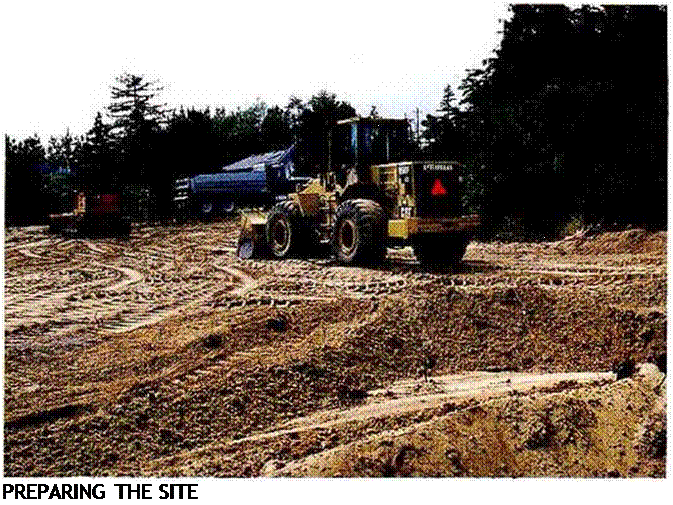

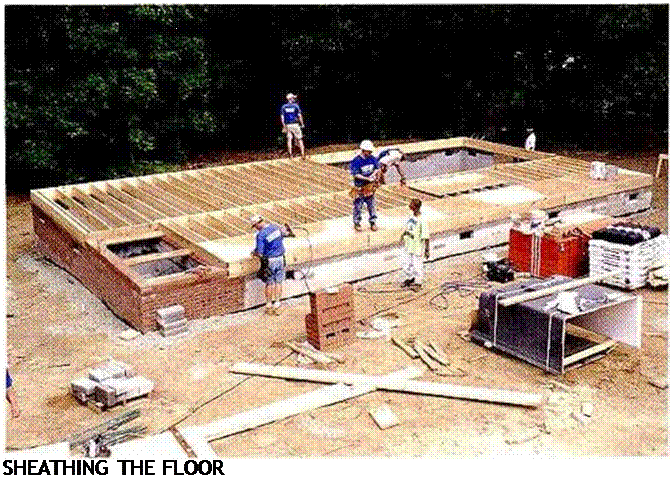

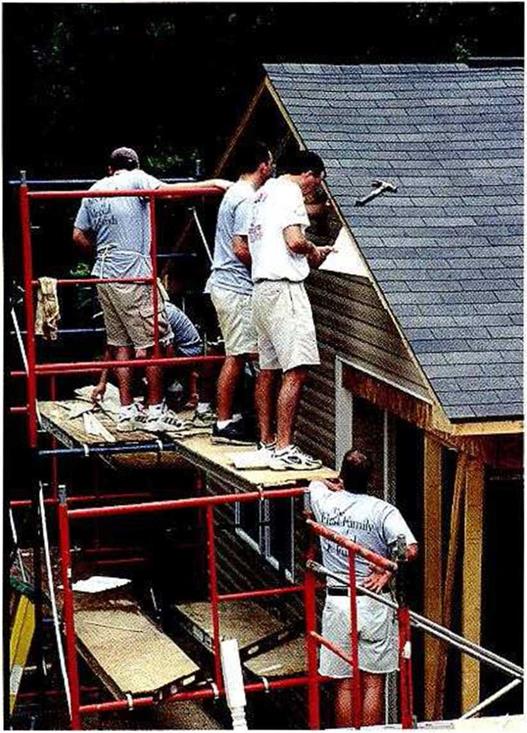
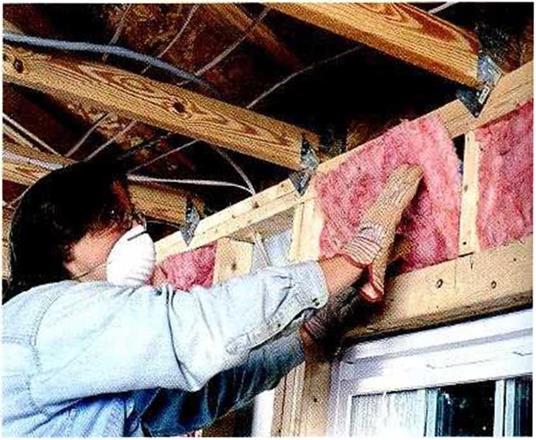

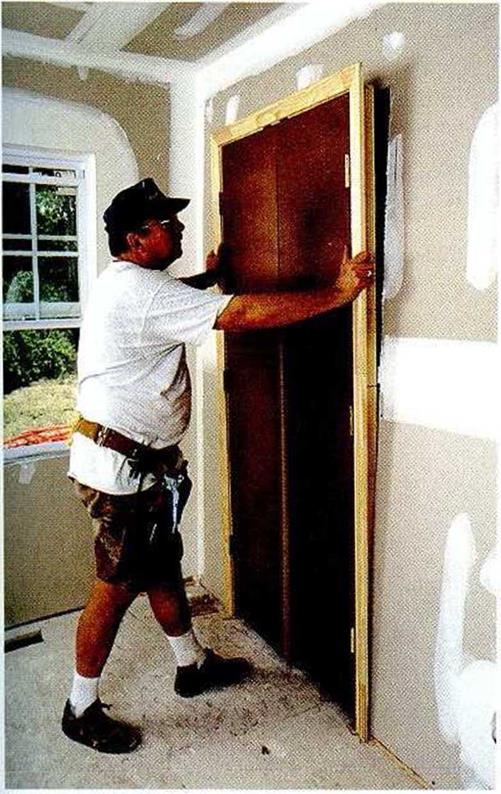


 When my brothers and 1 were building houses, we spent many hours planning and organizing so that we always knew what to do next, who would do it, and when and how it would be done. Organizing time and materials is an essential skill for any builder, whether that builder is working with professionals, friends, family, or Habitat volunteers. Staying organized and on top of the situation is especially important when working with volunteers and unskilled helpers. Careful planning, good organization, and effective communication will
When my brothers and 1 were building houses, we spent many hours planning and organizing so that we always knew what to do next, who would do it, and when and how it would be done. Organizing time and materials is an essential skill for any builder, whether that builder is working with professionals, friends, family, or Habitat volunteers. Staying organized and on top of the situation is especially important when working with volunteers and unskilled helpers. Careful planning, good organization, and effective communication will


 ^ Wall sections to show the “guts” of the floors, walls, or ceilings. Think of a wall section drawing as an apple that’s been sliced in half to reveal its core (see the illustration at left). Both section and detail plans (sec below) are sometimes drawn at a larger scale to better identify the details that wouldn’t show up as clearly in a smaller scale.
^ Wall sections to show the “guts” of the floors, walls, or ceilings. Think of a wall section drawing as an apple that’s been sliced in half to reveal its core (see the illustration at left). Both section and detail plans (sec below) are sometimes drawn at a larger scale to better identify the details that wouldn’t show up as clearly in a smaller scale.

 A plot plan lets you see, from above, the size of the lot and where your house will be placed on the land. It also shows where utilities like water and electricity are located.
A plot plan lets you see, from above, the size of the lot and where your house will be placed on the land. It also shows where utilities like water and electricity are located.


 This is the floor plan for a simple four bedroom house. With it you can see the size of the building, the arrangement of the living spaces, and the location of doors and windows.
This is the floor plan for a simple four bedroom house. With it you can see the size of the building, the arrangement of the living spaces, and the location of doors and windows.![Design for the future Подпись: DETAILS MAKE A DIFFERENCE. Built-in drawers, painted wood paneling, and a well-crafted valance above the window make this small space extra Special. [Photo • Richard Stringer.]](/img/1312/image023_1.gif)





 build a garage.
build a garage.

 Remember, you’re going to live in this neighborhood. There’s no time like the present to be friendly and to get to know your neighbors. If you’re building in a remote area, you’ll probably need a generator to get electricity to the site. I’ve built many houses using a portable, gas-powered generator. Make sure your generator is capable of supplying power to several tools at once.
Remember, you’re going to live in this neighborhood. There’s no time like the present to be friendly and to get to know your neighbors. If you’re building in a remote area, you’ll probably need a generator to get electricity to the site. I’ve built many houses using a portable, gas-powered generator. Make sure your generator is capable of supplying power to several tools at once. After high school, I headed south. The first framing job I worked on was in Los Angeles in 1950. There were lots of carpenters, all wearing white overalls, cutting different pieces of wood with sharp handsaws and nailing them together with 16-oz., curved-claw hammers. The pace was slow and methodical. A wall chalkline would be snapped on the floor. The bottom plate was nailed to the line. Comer posts were then set and a string pulled taut over posts from corner to corner. The length of each wall stud was measured from that string. Once the studs were cut and toe – nailed to the bottom plate, we would stand on
After high school, I headed south. The first framing job I worked on was in Los Angeles in 1950. There were lots of carpenters, all wearing white overalls, cutting different pieces of wood with sharp handsaws and nailing them together with 16-oz., curved-claw hammers. The pace was slow and methodical. A wall chalkline would be snapped on the floor. The bottom plate was nailed to the line. Comer posts were then set and a string pulled taut over posts from corner to corner. The length of each wall stud was measured from that string. Once the studs were cut and toe – nailed to the bottom plate, we would stand on
![Habitat for Humanity International Подпись: Jimmy Carter-President, Nobel Prize winner, Habitat volunteer. [Photo by Lisa Bell.]](/img/1312/image003_0.gif) The homebuilding process can be intimidating, especially if you haven’t been through a house construction project from start to finish. This book is here to help you. By gaining a good understanding of when, why, and how things are done, you’ll also gain confidence in your ability to build a house that’s comfortable, functional, and affordable. Take care, and hold on to your optimistic attitude. Enjoy the step-by – step journey and all the people who help out along the way.
The homebuilding process can be intimidating, especially if you haven’t been through a house construction project from start to finish. This book is here to help you. By gaining a good understanding of when, why, and how things are done, you’ll also gain confidence in your ability to build a house that’s comfortable, functional, and affordable. Take care, and hold on to your optimistic attitude. Enjoy the step-by – step journey and all the people who help out along the way. Obtain a Site
Obtain a Site



![Habitat for Humanity International Подпись: HEAVY EQUIPMENT READIES THE SITE. Initial site preparation is usually done with heavy equipment because of the sheer difficulty of clearing, grading, and digging by hand. [Photo Larry Haun.]](/img/1312/image012_3.gif)